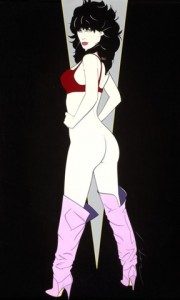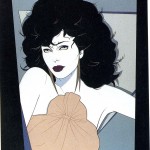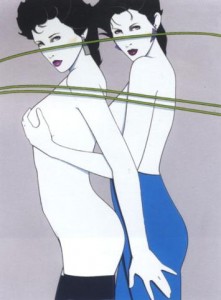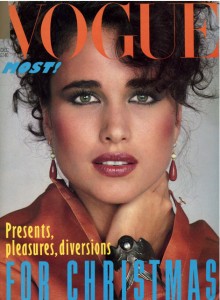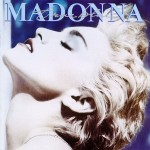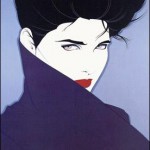 Sure, you’ve seen his work: at the mall poster shop, in the windows of countless nail salons (not really, but more on that later) or on the cover of that Duran Duran album. Meet the Nagel Woman — jet black hair, cocaine white skin and an expression that straddles aloof and alluring. Â
Sure, you’ve seen his work: at the mall poster shop, in the windows of countless nail salons (not really, but more on that later) or on the cover of that Duran Duran album. Meet the Nagel Woman — jet black hair, cocaine white skin and an expression that straddles aloof and alluring. Â
This is the kind of woman who buys her own Fuzzy Navels since no one would be foolish enough to try approaching her. Unless you’re a homosexual (like Liz Taylor, she collects gay friends at least a decade ahead of her time), obscenely rich or holding some primo Columbian snow, you’ve got no chance, so just hang back in the corner and admire the cold beauty, sleek lines and insouciant charm of Patrick Nagel’s immortal contribution to ‘80s art.
Born in 1945, this Los Angeles-based artist made his bones with an adrenalized burst of production from 1976 to 1984. Starting out as a freelance commercial artist and gaining a national profile with a regular series of illustrations that graced the monthly Playboy Adviser column, Nagel’s women in Hugh Hefner’s pages typically featured thigh-high boots, long, dark tresses and self-assured aereolas. His most well-known work then and now is the cover of Duran Duran’s 1982 album, Rio. The cover was a perfectly-timed marketing opportunity between three entities who understood the power of the perfectly composed image: the artist, the British band calibrating its second album for a global audience and a fledging cable channel called MTV. The potent synergy between these forces helped send each toward the pop stratosphere.
Aside from the subject’s atypical Joker-like grin, the Rio cover serves a suitable entry point as any for analyzing the Nagel Woman. The artist began his process by posing his model for a series of photographs — sometimes with clothes he personally selected for the session. Working off of these prints, he created simplified sketches of them and then composed his final works as acrylic on canvas paintings. The artist’s Miesian philosophy was to remove, remove and remove until you were left with the woman’s essential, iconic beauty. This means what you notice are her sleek countours, sculpted eyebrows and open smile – and not that the poor thing is missing a nose.
Looking at this unlined woman’s face it’s no wonder ‘80s Hollywood starlets such as Joan Collins and Joanna Cassidy (Blade Runner) commissioned flattering portraits from the artist to hang over their sofas – while away from their doting make-up artists and soft-focus lenses these beauties continued to harden and coarsen like anti-Dorian Grays.
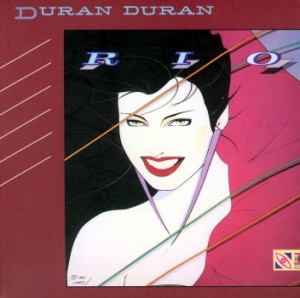
Nagel's best-known painting, Texas, used as the cover for Duran Duran's 1982 album, Rio, a star-making vehicle for both parties. (Courtesy of: Wikipedia)
As befitting Nagel’s academic training (he attended the Chouinard Art Institute and California State University, Fullerton), the artist had a formal understanding of how to use shape and color. Staying with the Rio cover, notice the diagonal lines that bisect the woman that are echoed in the earrings and stray hairs. These lines echo the swooping shape of the woman’s hair and seem to put her in motion. On a conscious level, you probably don’t even notice that the eyes and ears are oddly the same shape. Instead, you intuit that the elements are in harmony. The two shades of red used in the painting contrast dramatically with the woman’s fair skin and paired with the pale blue and lavender, show that Nagel’s strategy in creating this iconic work was to dramatically reduce his color palette to emphasize these shapes and contrasts. (Note that Nagel only created the main illustration — the surrounding C-shaped frame and type was created and tacked-on rather awkwardly by a separate designer.)
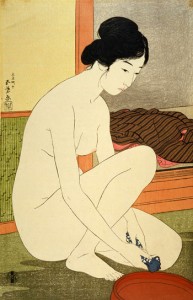
18th century Japanese woodblock prints were also key influences for Nagel. Note Nagel's adoption of a main figure against a neutral background. (Courtesy of: RobertGenn.com)
Perhaps what made the artist’s work so instantly iconic was its dramatic break from the times. While Nagel was attending art school in the 1960s, decorative posters made a comeback with the emergence of live rock shows and the psychedelic posters often plastered around town to promote them. As a strict formalist however, Nagel’s style was much cleaner and looked back to not only 1800s lithographic prints from Paris, but also to the Japanese wood block prints that originally inspired these French artists.

"Confetti" by Henri De Toulouse-Lautrec. The artist was a tremendous inspiration to Nagel in both subject matter and technique. Â (Courtesy of: GlobalGallery.com)
Of these French artists, the alcoholic chronicler of turn-of-the-century Paris decadance, Toulouse-Lautrec, created many of these touchstone works. Instead of the technicolor, swirling backgrounds commonly found in psychedelic posters of his era, Nagel instead referenced these Toulouse-Lautrec posters with little background (mostly in the hue of Payne’s Gray), a dominant image – often a woman – and a stylized illustration style that often included type. Earning his MFA in painting and graphic design, the artist also looked to the clean, symmetrical lines of Art Deco in his compositions.

'80s Playboy Playmate Shannon Tweed, one of the artist's frequent models for the Nagel Woman. (Courtesy: nndb.com)
Whether we want to call this a theme or obsession (though it’s worth noting that he typically worked through the night, fueled on candy bars and cigarettes), Nagel was also obviously focused on depicting women. It’s been speculated that the Nagel Woman was inspired by the artist’s wife, Jennifer Dumas, but as with the other models he was known to work with such as Playboy playmates Shannon Tweed and Cathy St. George, Nagel’s women tended to look the same regardless of the inspiration. Aside from their similar eyes and mouths, these women all typically had the same ice-cold beauty and taunting self-confidence.  They didn’t need your approval — you needed theirs. Regardless of how long you stared at them, they remained unknowable – and unattainable.
Even a casual survey of Nagel’s work reveals many similar works of beautiful, partially nude women staring blankly at the viewer. Since the artist was obviously working out variations on a theme, one wonders what exactly was going through his head as he sat in the dark, night after night composing his works. Maybe not much. According to a V Magazine profile, Nagel told friends that he didn’t really want to understand these women.  “They never come out in the sunlight,” he said. “They just stay up late and smoke and drink a lot.”  Although the artist certainly wasn’t a hermit — he enjoyed an active social life with his wife, taught at the Art Center College of Design, and often lunched at the Playboy Mansion — it’s likely he was also talking about himself.
What was the source of his angst? Â He couldn’t have been agonizing over creating the actual works, could he, considering how many he produced in such a short period of time? Â Perhaps he became bored and trapped by a successful formula — a numbing, claustrophobic sensation likely to be shared by anyone who spends more than a few minutes with his ouvre.
Regardless of any discontent the artist may have wrestled with, he faced no such struggles in finding an audience for his works. Building on a lucrative career as a graphic artist for blue chip corporations including IBM, Budweiser and of course, Playboy, Nagel created work that sold. When the artist had his first exhibition of fine art paintings in the early ‘80s, 4,000 people attended and the works sold out within 15 minutes. For those collectors who couldn’t afford his canvases, there were the limited-edition signed silkscreen poster prints authorized by his publisher, Mirage Editions – eventually 60 works in total — which also quickly sold out.  This pattern was repeated by his collectors with each succeeding release of his work in his lifetime. Finally, once these posters were licensed to be reprinted for the masses and began showing up at a poster shop near you – and eventually in every suburban den or bachelor pad – Nagel’s minimalist and at times, soft-core works were the stamp of the modern ’80s gentleman. For better or for worse, more than Warhol or Haring, this ubiquity made Nagel the pop artist of the decade.
Why was the Nagel Woman so popular? Let us count the ways:
-
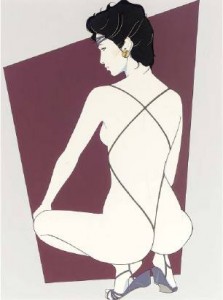
Nagel at his most tastefully erotic -- suitable for your den, dorm or bedroom. Â Â Â Â (Courtesy: AskArt.com)
Nagel knew good design. A trained fine arts painter and graphic designer, his works were immaculate compositions that perhaps predicted, but certainly embodied the new sleek aesthetic of the ‘80s. His style also reflected living in Los Angeles in the ’70s and ’80s, the nexus of West Coast minimalism, fashion, the entertainment industry and even the “Finish Fetish” — an emphasis on lacquered, manufactured surfaces inspired by custom car and surfboard design. With his love of Payne’s Gray (a likely nod to one of his inspirations, Toulouse-Lautrec) and the chalk white skin of his beauties, the artist practically worked in black and white so his prints went with everything – especially minimalist living rooms with grey carpet, bare walls, glass coffee tables and black leather couches. That guy in the Maxell cassettes ad? He definitely had a Nagel.
-

At Playboy, Nagel was annoited as the heir apparent to erotica legend Alberto Vargas, whose beauties were considerably softer and more pliant.Â
It wasn’t pornograpy, it was erotica. Nagel’s reputation certainly benefited from appearing in the pages of Playboy, where the Nagel Woman followed in the footsteps of erotica legend Alberto Vargas and the “Vargas Girl.” Through the alchemy of canvas and acrylic, these works weren’t to be confused with pin-ups or centerfolds, they were artistic renderings of beautiful women.  That meant even young men in high school and college could get away with putting these partially nude women on their walls without looking perverted, because they were…art.
-
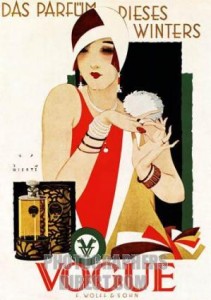
From their geometric backgrounds and designed font faces to the elegant lifestyle they depicted, Art Deco posters were a key influence for Nagel, such as this 1927 poster for a German perfume. (Courtesy: Art-deco-style.com)
His posters looked so exotic. And modern. Although many of his design influences were indeed ancient – whether they were Art Deco, French decorative posters or Japanese woodblock prints – Nagel’s expert synthesis of these influences resulted in works that looked like no one else’s on the market.
- The Nagel Woman was a badass. Unlike the artist’s posters, these women were not accessories. They were independent, elegant and extremely confident in their own sexuality.  This meant the Nagel Woman could be enjoyed by men and women alike.
- He created his works like products. With his background as a successful commercial artist, Nagel’s posters were both instantly accessible works of art (all of their pleasures were at the surface) and their own seductive advertisements for his work. Much like what his greatest patron, Hugh Hefner, did with his Playboy empire, Nagel created a sleek, sexy lifestyle brand to which his collectors aspired.
The post-Nagel influence on pop culture reached its peak with the backing band of black-clad vamps in Robert Palmer’s 1986 music video for “Addicted to Love.â€Â Although this was parodied just two years later by the rapper Tone Loc for his video of “Wild Thing,†it’s not clear that Mr. Palmer wasn’t in on the joke in the first place. Seeing these Nagel Women made literal and rigidly conforming to a style most appropriate for a Nagel poster or Vogue cover – they looked fairly ridiculous in any other context and Palmer’s leering glances toward his backing “band” throughout the video indicated that he understood this, too. When you see a real Nagel Woman in the flesh – especially in a group – she doesn’t look independent and powerful. She looks like a geisha (the Japanese influence holds).
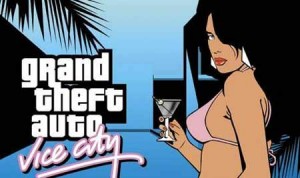
Nagel-inspired art for 2002's Grand Theft Auto Vice City -- though the artist likely wouldn't have endorsed the suntan or bikini top. Â (Courtesy of: GameGuru)
In the decades that followed, Nagel’s lasting influence on pop art has been limited and skewed toward the retro and camp. His aesthetic has endured in pop culture nonetheless – from any vixen in black thigh-high boots and the retro exploitation style found in Low Rider Magazine to the Nagelesque clip art you’ll continue to find in the windows of Asian beauty salons. In the case of the latter, as dated as these illustrations can look today, it’s worth noting that most of these nail salons are run by Vietnamese business owners and this Nagel-influenced art is designed to lure their target market of Asian-American women who aspire to this affluent, Amerasian standard of beauty – especially to its attendant pale skin cult.
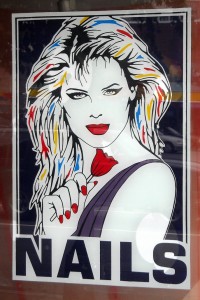
Nagel-inspired clipart spotted in a nail salon window. Â Guilt by association with this knock-off art has further degraded the Nagel brand.Â
Aside from his retro appeal, Nagel’s artistic legacy has been limited. Although he has works in institutions including the Library of Congress and the Smithsonian, the collector’s market for his works is modest at best – with asking prices for his limited-edition prints and original canvases comfortably below $10,000. (The largest owner of his works in the world is Hugh Hefner.)  The downside of Nagel’s Faustian bargain in creating commercial work that was so narrowly focused on sex and ’80s fashion was that it had no staying power outside of the decade. As good as Nagel was at what he did — and he was great — there were 87 other keys on the piano.
The Nagel brand was also permanently damaged by several studios capitalizing on the extreme demand for this work after his death by quickly flooding the market with knock-offs, in addition to some opportunistic releases authorized by his own publisher and estate.  What once seemed so fresh, modern and scarce became quite the opposite.  Like a Rubik’s Cube or a Flock of Seagulls bouffant, his work became an ‘80s sight gag.
On the plus side, Nagel didn’t have to witness his own decline. Although the artist scorned exercise and preferred his own late-night regimen of painting, junk food and nicotine, he accepted an invitation in early 1984 to participate in a 15-minute celebrity “Aerobathan†at a local health club to raise money for the American Heart Association.  By all accounts he enjoyed participating in this televised event and perhaps this encouraged him to start a new, healthier chapter of his life. Or perhaps it didn’t. We’ll never know because after the fundraiser, Nagel walked back to his car where he was later found dead of, wait for it…yes, a heart attack.  He was 38 years old.
* * *
SOURCES/ADDITIONAL READING:
“Philmology – Art of Patrick Nagel” (Truly eerie Nagel video montage that effectively captures the era.)

